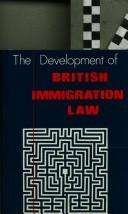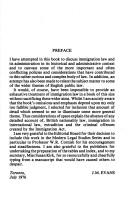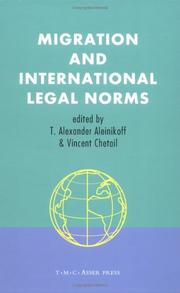| Listing 1 - 10 of 288 | << page >> |
Sort by
|

ISBN: 0709906633 9780709906636 Year: 1986 Publisher: London: Croom Helm,
Abstract | Keywords | Export | Availability | Bookmark
 Loading...
Loading...Choose an application
- Reference Manager
- EndNote
- RefWorks (Direct export to RefWorks)

ISBN: 0421202300 9780421202306 Year: 1976 Publisher: London: Sweet and Maxwell,
Abstract | Keywords | Export | Availability | Bookmark
 Loading...
Loading...Choose an application
- Reference Manager
- EndNote
- RefWorks (Direct export to RefWorks)
Book
ISBN: 9788889373378 8889373377 Year: 2005 Publisher: Napoli: Editoriale scientifica,
Abstract | Keywords | Export | Availability | Bookmark
 Loading...
Loading...Choose an application
- Reference Manager
- EndNote
- RefWorks (Direct export to RefWorks)
Book
ISBN: 1509922997 9781509922994 9781509945252 1509945253 Year: 2019 Publisher: Oxford: Hart,
Abstract | Keywords | Export | Availability | Bookmark
 Loading...
Loading...Choose an application
- Reference Manager
- EndNote
- RefWorks (Direct export to RefWorks)
Policing Humanitarianism examines the ways in which European Union policies aimed at countering the phenomenon of migrant smuggling affects civil society actors' activities in the provision of humanitarian assistance, access to rights for irregular immigrants and asylum seekers. It explores the effects of EU policies, laws and agencies' operations in anti-migrant smuggling actions and their implementation in the following EU Member States: Italy, Greece, Hungary and the UK.The book critically studies policies designed and implemented since 2015, during the so called 'European refugee humanitarian crisis'. Building upon the existing academic literature covering the 'criminalisation of migration ' in the EU, the book examines the wider set of punitive, coercive or control-oriented dynamics affecting Civil Society Actors' work and activities through the lens of the notion of ' policing the mobility society'. This concept seeks to provide a framework of analysis that allows for an examination of a wider set of practices, mechanisms and tools driven by a logic of policing in the context of the EU Schengen border framework: those which affect not only people, who move (qualified as third-country nationals for the purposes of EU law), but also people who mobilise in a rights-claiming capacity on behalf of and with immigrants and asylum-seekers
Book
ISBN: 0192896296 9780192896292 Year: 2023 Publisher: Oxford: New York: Oxford University Press,
Abstract | Keywords | Export | Availability | Bookmark
 Loading...
Loading...Choose an application
- Reference Manager
- EndNote
- RefWorks (Direct export to RefWorks)
The Immigration Law Handbook has established itself as the gold standard in the field and has become an invaluable resource for immigration practitioners including Asylum and Immigration Tribunal judges, barristers, solicitors, and caseworkers working in immigration, asylum, and human rights law.In this new edition, all sections have been updated to reflect the various changes to the immigration rules since 2018, especially as a result of Brexit and the COVID-19 pandemic. Most notable is the inclusion of the Immigration and Social Security Co-ordination (EU Withdrawal) Act 2020 which made provision to end rights to free movement of people under EU law and to repeal other EU law relating to immigration. Three new Statutory Instruments set the transitional and saving provisions to which the Immigration (European Economic Area) Regulations 2016 are now subject. Four more new Statutory Instruments are also included: The Immigration (Guidance on Detention of Vulnerable Persons) Regulations 2018 and three relating to Brexit: The Immigration (European Economic Area Nationals)(EU Exit) Order 2019; Immigration (Citizens' Rights Appeals) (EU Exit) Regulations 2020; and The Citizens' Rights (Frontier Workers) (EU Exit) Regulations 2020.The Immigration Rules have been subject to 22 statements of changes since the last edition, some of which are significant. This edition captures all changes in the Immigration Rules up to and including those coming into force in July 2021. The Tribunals, Courts and Enforcement Act 2007, the Tribunal Procedure (First-tier Tribunal) (Immigration and Asylum) Rules 2014 and the Tribunal Procedure (Upper Tribunal) Rules 2008 all include amendments made in response to circumstances arising as a result of the COVID-19 pandemic. The Procedure Rules and Practice Directions section has been expanded to include practice statements and brought up to date with the latest rules and guidelines. Finally, the European Materials section has been streamlined to include just the two most relevant, relating to free movement and workers' rights.Coverage of recent new legislation sits alongside existing important legislation to maintain the strengths of the handbook as a reference tool whilst providing the reader with up-to-date access to all new developments in a single volume. Useful links to online materials are provided to guide readers towards supplementary information.
Book
ISBN: 3848730014 9783848730018 3848730014 9783848730018 Year: 2016 Publisher: Baden-Baden: Nomos,
Abstract | Keywords | Export | Availability | Bookmark
 Loading...
Loading...Choose an application
- Reference Manager
- EndNote
- RefWorks (Direct export to RefWorks)
Book
ISBN: 9781789902259 1789902258 1789902266 Year: 2021 Publisher: Northampton, England : Edward Elgar Publishing,
Abstract | Keywords | Export | Availability | Bookmark
 Loading...
Loading...Choose an application
- Reference Manager
- EndNote
- RefWorks (Direct export to RefWorks)
"As the law and politics of migration become increasingly intertwined, this thought-provoking Research Handbook addresses the challenge of analysing their relationship. Discussing the evolving theoretical approaches to migration, it explores the growing attention given to the legal frameworks for migration and the expansion of regulation, as migration moves to the centre of the global political agenda. The Research Handbook demonstrates that the overlap between law and politics puts the rule of law at risk in matters of migration as advocates around the globe increasingly turn to law to address the challenges of new migration politics. Presenting a fresh mapping of current issues in the field, it focusses on institutions of migration and analyses the securitization of migration management and the strengths and weaknesses of the Global Compact for Safe, Orderly and Regular Migration. Written by leading scholars specialising in a range of disciplines, the Research Handbook on the Law and Politics of Migration will be an illuminating read for academics and students of migration studies with backgrounds in law, politics, criminology, sociology, history, geography and beyond"--
Book
ISBN: 1627223878 9781627223874 Year: 2015 Publisher: Chicago: American Bar Association,
Abstract | Keywords | Export | Availability | Bookmark
 Loading...
Loading...Choose an application
- Reference Manager
- EndNote
- RefWorks (Direct export to RefWorks)
At its most basic, 'crimmigration law' describes the convergence of two distinct bodies of law: criminal law and procedure with immigration law and procedure. For most of the nation's history, these operated almost entirely free of the other. Criminal law and procedure was thought to be the province of prosecutors, criminal defense attorneys, and the state and federal judges who oversee criminal prosecutions every day. Immigration law, in contrast, was confined to immigration courts housed within the executive branch of the federal government and staffed by immigration attorneys, immigration judges, and prosecutors employed for many years by the Immigration and Naturalization Service and now the Departments of Homeland Security or Justice. With this in mind, Crimmigration Law lays out crimmigration law's contours. It tracks the legal developments that have created crimmigration law and explains the many ways in which the stark line that once appeared to keep criminal law firmly separated from immigration law has melted away. In doing so, it highlights crimmigration law's most salient features - its ability to substantially raise the stakes of criminal prosecutions by dramatically expanding the list of crimes that can result in removal from the United States, its willingness to freely rely on crimes that apply only to migrants, and its vast dependence on detention as a means of policing immigration law. Crimmigration law is simply too new to have gained widespread recognition until the last few years. Several recent law enforcement trends and judicial decisions, including U.S. Supreme Court cases, have drastically changed the legal landscape such that, today, crimmigration is developing into a distinct field of law that is a palpable feature of law enforcement in communities throughout the country. This book is intended to provide readers with a fundamental understanding of this developing area of law. It includes case studies and 'problem scenarios' that place the concepts discussed within each chapter in a real-world context in addition to 'practice pointers' designed to give crimmigration lawyers and students of crimmigration law tips and techniques to help them implement the tools into their daily practice. With its comprehensive yet accessible approach, Crimmigration Law is the first book of its kind and the definitive guide on the subject.
Emigration and immigration law --- Emigration and immigration law --- United States.

ISBN: 9067041572 9789067041577 Year: 2003 Publisher: The Hague : Asser press,
Abstract | Keywords | Export | Availability | Bookmark
 Loading...
Loading...Choose an application
- Reference Manager
- EndNote
- RefWorks (Direct export to RefWorks)
Book
ISBN: 9781849460750 1849460752 Year: 2010 Publisher: Oxford: Hart,
Abstract | Keywords | Export | Availability | Bookmark
 Loading...
Loading...Choose an application
- Reference Manager
- EndNote
- RefWorks (Direct export to RefWorks)
| Listing 1 - 10 of 288 | << page >> |
Sort by
|

 Search
Search Feedback
Feedback About UniCat
About UniCat  Help
Help News
News